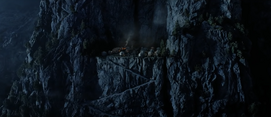
The Hold of Dunharrow, or more simply Dunharrow, was a fortress on a high clifftop used as a refuge by the Rohirrim. It was hidden in the White Mountains[1] above the vale of Harrowdale, between the mountains of Írensaga, Starkhorn, Dwimorberg.
Description
Dunharrow was positioned on a flat upland of heath overlooking Harrowdale, the valley of the river Snowbourn. It was located at the feet of the mountain Starkhorn, with the peak of Írensaga in the north, and the large dark mountain Dwimorberg to the east. The refuge could be reached by way of a winding path known as the Stair of the Hold. This path was lined with statues known as the Púkel-men, statues originally carved by the Men of the White Mountains, in the likeness of the Drúedain. The Firienfeld, a large grassy area for the encampment of soldiers, was right before the stair and below the clifftop. Large carved stones marked the entrance to the Dimholt forest, with a road leading to the Paths of the Dead.[2][3]
The hamlets of Upbourn and Underharrow lay north of here, in the dale.
History
The Hold of Dunharrow had been used as a natural stronghold by the Middle Men of the White Mountains during the Second Age several centuries before Rohan, and was scouted by Brego and his son Baldor in the early years of the kingdom.
In TA 2759, during the war between Rohan and Dunland, Rohirrim refuge-seekers led by Fréaláf took shelter in Dunharrow during the Long Winter. From there Fréaláf led a successful raid to retake Edoras.
Later, in the year TA 2851, Brytta Léofa was slain by Orc refugees from the War of the Dwarves and Orcs while riding from the fortress.[4]
In TA 3019, during the War of the Ring, Aragorn, along with Legolas, Gimli, and the Grey Company, passed through the Hold of Dunharrow on their way to the Paths of the Dead. After a Nazgûl passed over Edoras, Gandalf commanded that muster of Rohan be moved to Dunharrow. Having ridden by mountain paths, Théoden arrived two days later and stayed the night before riding for Minas Tirith.[2][5]
Etymology
Dunharrow is a Modern English form of Dúnharg[6] or Dūnhaerg in Old English meaning "the heathen fane on the hillside".[7]
The name likely contains the words dún ("mountain, hill") and harrow, the modernization of haerg ("temple").
Underharrow's name denotes 'under Dunharrow', as the hamlet was down the valley from Dunharrow.
In other versions
Translations
| Foreign Language | Translated name |
| Amharic | ዱንሃርሮው |
| Arabic | دونهاروو |
| Armenian | Դունհարրու |
| Basque | Sagrarioa |
| Belarusian Cyrillic | Дунhарроў |
| Bengali | ডানহারেরও |
| Bulgarian Cyrillic | Дунхаррощ |
| Burmese | ဒန်းဟဲရိုး |
| Chinese | 登哈洛 |
| Chinese (Continental) | 黑蛮祠 |
| Danish | Dysterharge |
| Dutch | Dunharg |
| Finnish | Dunharg |
| French | Dunhart |
| Georgian | დანჰრორო |
| German | Dunharg |
| Greek | Ντανχάρροου |
| Gujarati | ડનહરો |
| Hebrew | דונהארו |
| Hindi | डुन्हर्रोव |
| Italian | Fanclivo |
| Japanese | 馬鍬砦 |
| Kannada | ಡುನ್ಹಾರ್ವ್ |
| Kazakh | Дұнһарроу (Cyrillic) Dunharrow (Latin) |
| Korean | 던하 로우 |
| Kyrgyz Cyrillic | Дунhарроw |
| Laotian | ດນຮະຣຣໂວ |
| Marathi | डुन्हर्रोव |
| Mongolian Cyrillic | Дунhарроү |
| Nepalese | डुन्हर्रोव |
| Norwegian | Dunhov |
| Persian | دونهارو |
| Portuguese | Templo da Colina (Brazil)
Fano da Colina (Portugal) |
| Punjabi | ਡੁਨ੍ਹਰ੍ਰੋਵ |
| Russian | Дунхарроу |
| Sanskrit | डुन्हर्रोव् |
| Serbian | Дунхароу (Cyrillic) Dunharou (Latin) |
| Sinhalese | ඩන්හාරෝ |
| Spanish | El Sagrario |
| Swedish | Duneharv |
| Tamil | துன்ஹர்ரோவ் |
| Telugu | దుంహ్రరౌ |
| Thai | ดันแฮโร่ว์ |
| Ukrainian Cyrillic | Дунхарроу |
| Urdu | دنحرراوو |
| Yiddish | דונהאַרראָוו |
References
- ↑ The Lord of the Rings: A Reader's Companion, "Unfinished index for The Lord of the Rings", pg. 407 (entry Hold of Dunharrow)
- ↑ 2.0 2.1 The Lord of the Rings, Vol. III: The Return of the King, Book Five, Ch. III: "The Muster of Rohan"
- ↑ The Atlas of Middle-earth, The Lord of the Rings, "Dunharrow"
- ↑ The Lord of the Rings, Appendix A, Annals of the Kings and Rulers, II: "The House of Eorl"
- ↑ The Lord of the Rings, Vol. III: The Return of the King, Book Five, Ch. II: "The Passing of the Grey Company"
- ↑ The Lord of the Rings, Appendix E, "Pronunciation of Words and Names", Note
- ↑ The Lord of the Rings: A Reader's Companion, "Nomenclature of The Lord of the Rings", pg. 769 (entry Dunharrow)